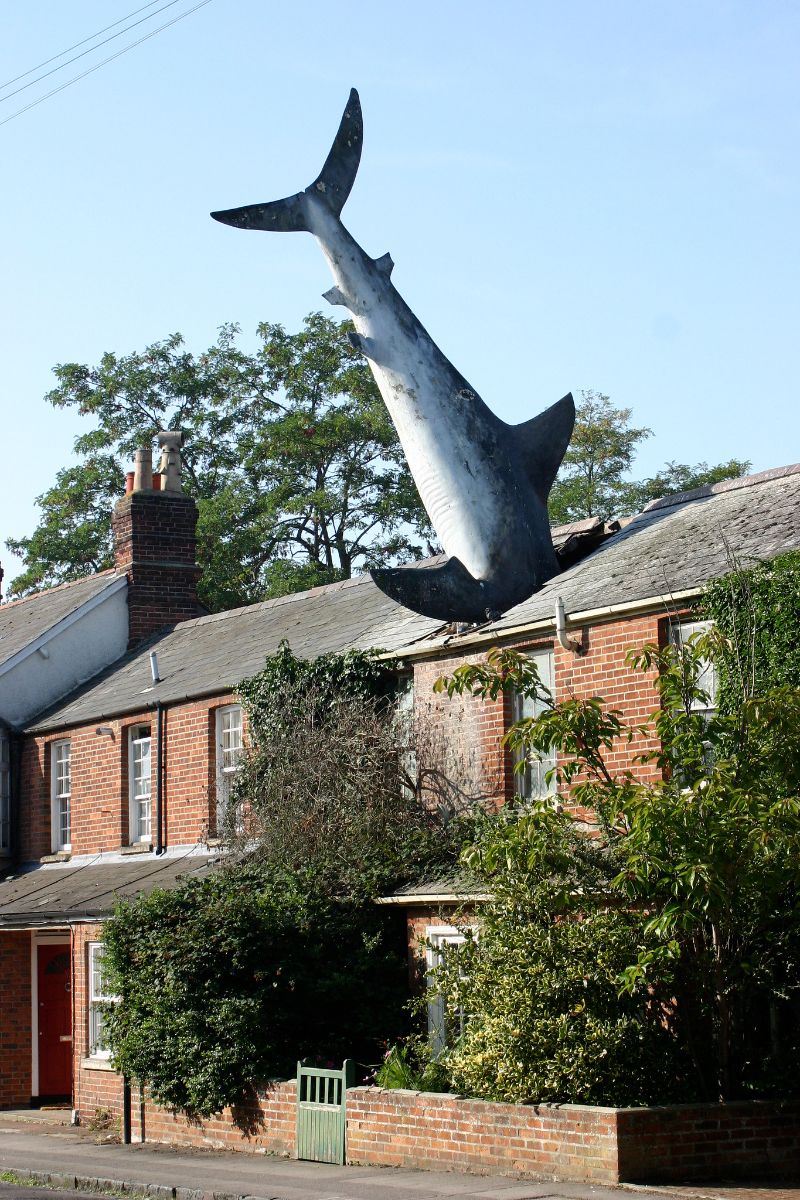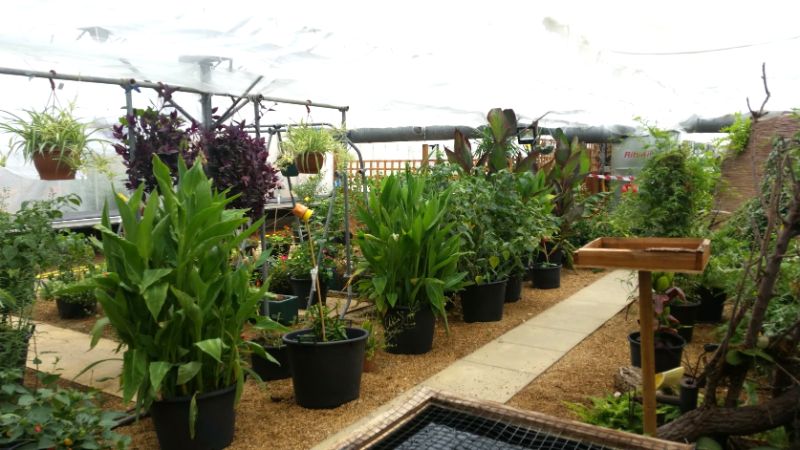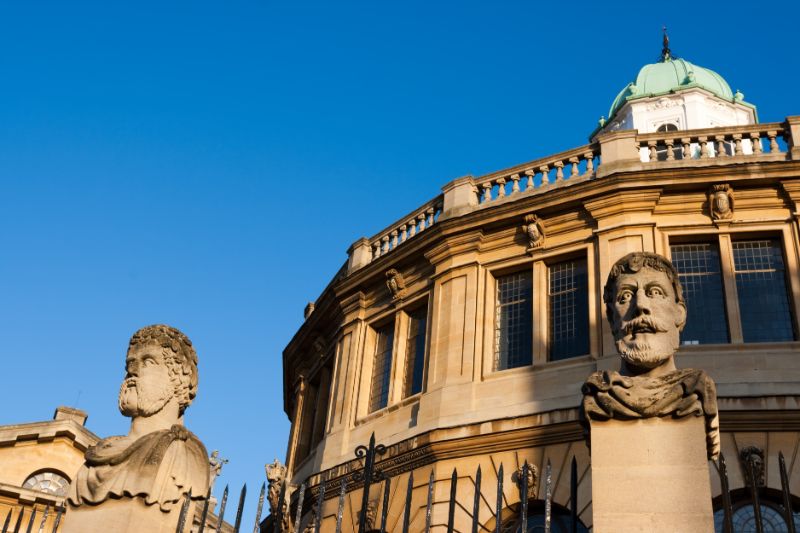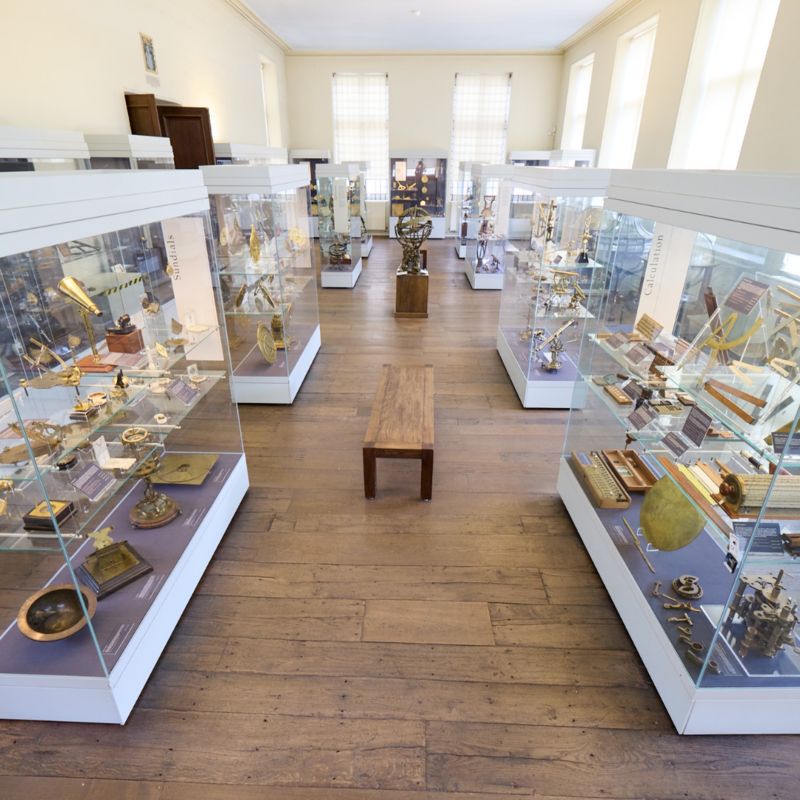This post contains affiliate links. Read the full disclosure here.
Home to the oldest University in England, Oxford is one of those cities where you can just feel the history and the scholarship seeping out of the buildings.
It’s packed with characterful architecture, gorgeous landscapes, and literary tradition. For Harry Potter fans it’s a must-see – every other street looks like something out of Hogwarts and many scenes from the movies were shot here.
TV and murder mystery fans will also recognise much of the city from adaptations like Morse, and it’s played an important part over the centuries in many historical events including the English Civil War.
There’s plenty to explore in this lovely Cotswold town, from the mellow golden buildings to the green spaces, riverside locations, and the colleges themselves.
Table of Contents
- Ashmolean Museum
- Port Meadow
- Walk the Bridge of Sighs, St Helen’s Passage and the Radcliffe Camera
- See the Headington Shark
- Cutteslowe and Sunnymeade Park
- Cutteslowe Garden Project
- Spot the Sheldonian Heads
- History of Science Museum
- Evensong at Christ Church College Chapel
- Bookworms’ Paradise
- Honourable Mentions
Ashmolean Museum

What it is: In a city full of amazing museums, the Ashmolean is probably the most famous. It’s been around since 1683, making it pretty much the first really modern example of a museum. Its exhibits are world famous and divided into themed galleries – mummies, art, textiles, conservation, reading and writing. And that’s just the lower ground floor. Several of the art collections are the largest in the world.
Why we liked it: Quite apart from the glorious architecture, we loved hearing about all the amazing people behind the exhibitions and displays. We also managed to time it so we coincided with one of the free hour long guides (approximately) run by the volunteers who love working here – and oh, does it show. Another gallery that was a big hit was the ancient floor – China, Egypt, Greece, all brought together with interactive displays, and the artist in the family could barely tear themselves away from the Pre-Raphaelites and others.
More information: Ashmolean Museum
Address: Beaumont St, Oxford OX1 2PH
Opening Hours: 10am to 5pm every day (check directly with venue for Bank Holiday opening hours).
Port Meadow

What it is: There are two rivers running through Oxford, the Cherwell and the Thames, and it’s that last one that runs right through the middle of Port Meadow, often described as “Oxford’s oldest monument”. There are several species that call this lovely open space and SSSI home, including wildfowl, ponies, horses, and cattle. The Burgess Field is right next door, and fishing is allowed here with the correct permits and rod licence.
Why we liked it: We loved the fact we were at one of the most ancient sites in the British isles, and the walks were gorgeous. It didn’t matter whether we stayed on the common itself or went across the river on to the Thames towpath. Spotting all the different types of wildflower in the meadow kept us nicely occupied, and after all that walking, the static BBQs and picnic benches close to the entrance on Godstow Road were a sight for sore eyes.
More information: Port Meadow
Address: Walton Well Rd, Oxford OX2 6ED
Opening Hours: 24/7, all year round
Walk the Bridge of Sighs, St Helen’s Passage and the Radcliffe Camera

What it is: The first of these two must be one of the most photographed locations in Oxford – after all, where else can you pretend you’re in Venice without having to set foot on a plane? It’s actually more similar to the Rialto than the Bridge of Sighs in Venice, however. The real name of the Bridge of Sighs is the Hertford Bridge, since it connects two areas of Hertford College. The myth (and it is a myth) goes that centuries ago, Hertford College decided it needed to help its students get fitter. They then closed off the bridge between the new and old quadrangles to make students take the stairs to get from one part of the college to the other. It is a myth, by the way – not only is the quadrangle bridge always open, but you actually have to take more stairs than if they didn’t use the bridge. It’s a very pleasant walk from here to the Radcliffe Camera, or head direct into St Helen’s passage for a glimpse of history.
Why we liked it: You do have to get the timing right as it’s always so crowded around the Bridge of Sighs and the Radcliffe Camera locations, but both made up two of our favourite selfie backgrounds in the city. We also really appreciated the fact the Bridge of Sighs is right next to the Bodleian Library and connects up to St. Helen’s Passage. We love it when we can see history peeking through into modern life, and St. Helen’s Passage is home to part of the original north-east wall of the city. (It’s actually Grade I listed.) The passage was previously called Hell Passage, and the artist in the family loved the fact that Jane Burden lived here with her family in the middle of the 19th century. Jane caught the eye of Dante Gabriel Rossetti, Edward Burne-Jones, and William Morris (later her husband) and was a model for many of their paintings.
More information: Start at Hertford College or Radcliffe Camera
Address: Bridge of Sighs, New College Ln, Oxford OX1 3BL; St Helen’s Passage, off New College Lane, Oxford, Oxfordshire, OX1 3SU; Radcliffe Camera, Radcliffe Square, Oxford, OX1 3BG; Radcliffe Camera, 9am to 9pm Monday to Friday; 10am to 6pm Saturday; 11am to 7pm, Sunday.
Opening Hours: 24/7 all year round (Bridge and St Helen’s Passage).
See the Headington Shark

What it is: This is a little way out of the city centre, but worth seeing just for its quirkiness. The shark first crashed into the roof of this unassuming ordinary home in Headington in August 1986, gaining attention from around the world. It wasn’t always popular with the local council, but as the years have gone on it’s been added to the city’s heritage register.
Why we liked it: It’s obviously not a real shark, but made out of fibre-glass. It’s so unexpected that it’s hard not to be engaged and amused by it, and locally people are so used to it they barely bat an eyelid any more. Also, it was another great background for our selfies.
More information: Headington Shark
Address: 2 New High Street, Headington, Oxford OX3 7AQ
Opening Hours: Can be viewed 24/7 all year round
Cutteslowe and Sunnymeade Park

What it is: This Green Flag award-winning park in the north of Oxford is the largest in the city. It covers 42 hectares and combines Sunnymead Park in the south and Cutteslowe Park in the north; a bridge was built in 2002 to join the two together. There are park runs, allotments, and plenty of other events all year round. There’s always plenty going on here, and there are table tennis tables, football pitches, and a skate park. In the summer you might see balloons taking off here, and we also enjoyed a geocaching session.
Why we liked it: The community woodland and the wildlife area were a big hit, especially when we found out that they used to be allotments. The park was used in World War Two to grow vegetables.
More information: Cutteslowe and Sunnymead Park
Address: Elsfield Way, Oxford OX2 8NP
Opening Hours: 24/7 all year round.
Cutteslowe Garden Project

What it is: This horticultural therapy project in Cutteslowe Park is an unexpected treasure, open to the public, and tucked away in Cutteslowe and Sunnymead Park in Oxford.
Why we liked it: We enjoyed the atmosphere and the venue, especially the Tropical House and Aviary, which was so colourful and lively. We enjoyed the parrots, butterflies, and other micro beasts, and were very taken by the tortoise. Depending on the time of year, you might be lucky enough to see the butterflies hatching – usually from around the end of March or start of April through to about September and October.
Address: Cutteslowe Garden Project, Cutteslowe Park, Harbord Road, Oxford, OX2 8ES.
Website URL: Cutteslowe Garden Project
Opening Hours: 10am to 5pm Tuesday to Saturday; the Tropical House & Aviary usually closes about an hour before the Garden Projects.
Spot the Sheldonian Heads

What it is: These busts are known as the Oxford Emperors, the Emperor Heads, and sometimes as the Twelve Apostles – even though there are 17 in total. They sit on top of the stone columns around the Sheldonian Theatre, which you’ll find on Broad Street (the eastern end). The exact name for these busts is “herms” – and that’s because they portray the shoulders and the head of all the men. The original heads were created in 1669. These aren’t the original heads, however – the weather, vandalism, and the pollution in the air in Oxford in Victorian times all meant they’ve needed to be replaced a couple of times. The ones you can see now were created in 1972 although the sculptor who put them together, Michael Black, used engravings and other sources to keep them faithful to the original. He even managed to track down five of the original heads in gardens around Oxford and two more in Herefordshire.
Why we liked it: They might look similar at first, but actually they’re all different, with unique expressions, plus different beard types. We had so much fun trying to imitate their expressions and taking selfies. Plus, they’re right outside the Museum of Science, which is a great visit in its own right. And depending on the time of year, you might see them sporting traffic cones, made up smiles, and even paint. (Mainly due to the high jinks of local undergraduates…) Since nobody knows who they really represent, you can also make up pretty much any story you like to go with them.
Address: Sheldonian Theatre, Broad Street, OX1 3AZ
More information: Sheldonian Heads
Opening Hours: Can be viewed 24/7 all year round
History of Science Museum

What it is: Housed in what is thought to be the oldest purpose-built museum building still extant in the world, you can find out about astronomy, timekeeping, maths, physics, chemistry, microscopes, medicine, and telecoms in the galleries in this building, as well as see portraits of so many of those involved over the years. Like many of the museums in the city, this one is part of the University.
Why we liked it: This museum really brings science to life, and the website is an exhibit in itself. There are always special exhibitions and events going on, previous topics have included radio waves, astronomy, and different personal stories of the COVID-19. We especially liked the sundials, astrolabes, and medical instruments. And a special mention has to go to Einstein’s Blackboard – no, really. (Told you the scholarship seeps out of the walls!)
Address: Broad St, Oxford OX1 3AZ
More information: History of Science Museum
Opening Hours: 12 noon to 5pm Tuesday to Sunday
Evensong at Christ Church College Chapel

What it is: Whether you’re especially religious or not, there’s something quite magical about listening to evensong in Christ Church. It doubles as the Diocese of Oxford cathedral church and the College Chapel, and often hosts art, drama, music and other events. Times of the services can vary so check the website before attending.
Why we liked it: The acoustics in the chapel are truly gorgeous, combined with the fact that it’s visually stunning, built in the 1100s. Plus, it’s a unique site in the Church of England; no other college chapel doubles as the local cathedral.
Address: St Aldate’s, Oxford OX1 1DP
More information: Christ Church College Chapel
Opening Hours: Check times of services before visiting; evensong is usually at 6pm.
Bookworms’ Paradise

What it is: There are so many buildings and locations in Oxford with literary associations of one kind or another that we couldn’t actually choose just one to keep the family bookworms entertained. So instead, we put together our own kind of unofficial trail, taking in Harry Potter movie locations via our downloadable map; the self-guided Alice in Wonderland locales; links to J.R.R. Tolkien, C.S. Lewis, and the rest of the “Inklings”, and then on to the libraries.
Why we liked it: Making the connections between all the different authors over the years was like walking a literary timeline. Nothing beats the Bodleian, but Weston Library just over the road and Oxford County Library also proved popular with the literary culture vultures in the clan. We also all loved the Gladstone Link, the underground tunnel between the Old Bodleian and the New Bodleian, and the free exhibitions going on in the Weston.
Address: Suggested start point – Bodleian, Broad St, Oxford OX1 3BG
More information: Use this page for the Harry Potter self-guided tour app and option to create your own tours; also this for the Bodleian
Opening Hours: Bodleian Reading Rooms 9am to 9pm Monday to Friday; 10am to 4pm Saturday; 11am to 5pm Sunday. Weston Library: 9am to 7pm Monday to Friday; 10am to 4pm Saturday. Check with the university for vacation opening hours and public access times. Oxford County Library: 9am to 8pm Monday to Thursday; 9am to 5.30pm Friday and Saturday.
Honourable Mentions

If you like nothing better than a pleasant walk by water then you’re spoiled for choice in Oxford. Check out the Oxford Canal and River Trust suggested spots to visit or watch punting and boats on the River Cherwell. Alternatively, if it’s green space you’re looking for, check out Christchurch Meadow, Shotover Country Park, South Park, Florence Park, or the War Memorial Garden. And if you’d like to take in the slightly less well-known picturesque corners of Oxford, head for Iffley Village or check out the pretty multicoloured buildings on Holywell Street. Simply exploring the different colleges is also a thoroughly enjoyable pastime in Oxford, although it’s usually a good idea to double check in advance on the rules for public access, as they do vary.
Then there are the museums – there are so many museums in Oxford it can be tricky to choose. As well as those we’ve already mentioned, others include the Pitt Rivers Museum (though the world famous shrunken heads collection has long since been removed) and the Museum of Oxford. Explore the lanes of the Covered Market or admire the beautiful interior of Oxford Town Hall.












Leave a comment